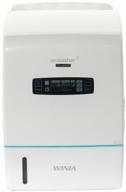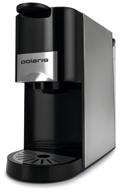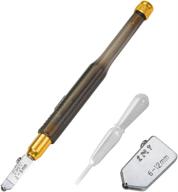Similar products
Choosing the Right Brushes and Rollers for Any Painting Project
Having the right painting tools for the job will make your painting project go faster and turn out better. The main tools for painting include brushes, which are used for cutting in edges and painting trim, and rollers, which are used to quickly cover large flat surfaces like walls and ceilings.
Types of Paintbrushes
There are several types of brushes designed for different purposes:
- Angled sash brush - great for cutting in edges and reaching corners
- Trim brush - has short stiff bristles perfect for doors, windows, and trim
- Wall brush - large brush with long bristles to quickly paint large surfaces
- Stencil brush - small brush for painting intricate patterns
Brush Bristle Materials
Paintbrushes are made with either natural or synthetic bristles:
- Natural bristles are best for oil-based paints and provide a smoother stroke
- Synthetic bristles work well for latex paints and are easier to clean
Choosing the Right Roller Cover
| Roller Cover Material | Best For |
|---|---|
| Microfiber | Smooth surfaces, minimal lint/shedding |
| Foam | Rough surfaces, absorbs more paint |
| Woven polyester | All-purpose use, sheds less |
The nap length, or pile height, also makes a difference. Shorter naps like 1/4" are good for smooth surfaces, while longer naps like 3/4" work well on uneven textures.
Tips for Choosing Painting Tools
- Use angled sash brushes for cutting in edges and reaching corners
- Choose synthetic brushes for latex paints and natural bristles for oils
- Pick the roller cover material and nap length for your surface type
- Use a paintbrush comb and liner to keep brushes clean
- Clean rollers thoroughly when done and store in an airtight bag
Investing in the right brushes and rollers for your particular painting project will make the job much easier and give you professional looking results. Planning ahead helps ensure you have the correct tools ready to go so you can paint efficiently and achieve a high-quality finish.
Types of Paintbrushes and Their Uses
Choosing the right type of paintbrush for your project can make a big difference in the final results. Here are some of the most common types of brushes and their best uses:
Sash Brush
The sash brush has a wide, flat head with tapered edges. The bristles are usually a blend of stiff and flexible. Uses include:
- Painting broad surfaces like walls, ceilings, siding
- Cutting in edges along trim and corners
- Both latex and oil-based paints
Angled Sash Brush
This brush is similar to a sash but with an angled wood block. It excels at:
- Reaching into corners and around trim
- Cutting in edges in tight spaces
- Any type of paint
Trim Brush
Trim brushes have short, stiff bristles in a thin, rectangular shape. Ideal uses:
- Painting balusters, shutters, baseboards
- Staining small furniture pieces
- Oil-based paints and stains
Chip Brush
Chip brushes are inexpensive with soft, thick bristles. Best for:
- Applying primer, sealers, or stains
- Touch-ups and small projects
- All paint types
Choosing brushes with the right shape, bristle type, and stiffness for your particular painting task will make the job much easier. Investing in quality brushes also leads to a more professional looking finish.
Natural vs. Synthetic Paintbrush Bristles
Paintbrushes are made with either natural bristles from animal hair or synthetic bristles made from nylon and polyester filaments. Each material has advantages and disadvantages.
Natural Bristle Brushes
Natural bristles are most commonly made from hog hair or a blend of hog and ox hair. Benefits include:
- Soft tips hold more paint
- Flag at the ends for smooth, even flow
- Best for oil-based paints
- Provide a luxurious feel
Downsides to natural bristles:
- Cost more than synthetic
- Absorb water from latex paints
- Prone to shedding
- Can be damaged by solvents
Synthetic Bristle Brushes
Synthetic filaments are made from nylon, polyester, or a blend. Pros of synthetic bristles:
- Affordable option
- Work well with latex paints
- Easy to clean with just soap and water
- Hold their shape over time
Downsides of synthetics:
- Doesn't provide as smooth of a brush stroke
- Can leave paint lines or ridges
- Not ideal for oil-based paints
- Prone to matting
Weigh the pros and cons of each when choosing paintbrushes for oil or latex paint. Well-cared for natural and synthetic brushes each serve a purpose.
Choosing the Right Roller Cover Material
Roller covers come in a variety of materials, each with their own benefits. The three most common types are microfiber, foam, and woven polyester.
Microfiber Roller Covers
Microfiber roller covers consist of very finely woven fibers that create a smooth texture. Advantages of microfiber covers:
- Provide a smooth, lint-free finish
- Ideal for gloss and semi-gloss paints
- Virtually no paint absorption or shedding
- Easy cleanup with soap and water
Best uses for microfiber covers are on smooth surfaces like drywall, plaster, and wood trim.
Foam Roller Covers
Foam covers have an open cell structure that absorbs paint. Benefits of foam covers:
- Work well on rough surfaces like concrete and stucco
- Hold more paint than other materials
- Provide good coverage on textured surfaces
- Inexpensive option
Foam covers tend to produce a slightly stipled finish requiring a second coat.
Woven Polyester Covers
Polyester fabric covers provide a balance of smoothness and paint absorption. Pros of polyester:
- Minimal shedding or lint
- Applies paint evenly
- All-purpose use on most surfaces
- Good for latex and oil-based paints
Consider the surface type and paint finish when choosing between microfiber, foam, and polyester roller covers.
Getting the Most from an Amazon Prime Subscription for Painting Supplies
An Amazon Prime membership can save you money on your painting supplies and tools. Here are some tips to maximize the value from your Prime subscription for painting projects:
Take Advantage of Free Shipping
One of the biggest Prime benefits is free two-day shipping on millions of items. This means no shipping fees for Prime members. Stock up on paint brushes, rollers, trays, drop cloths, painters tape, and more without added shipping costs driving up the total.
Buy in Bulk with Subscribe & Save
Set up Subscribe & Save for items you use frequently like paint rollers, brush cleaners, plastic paint buckets, and sandpaper. Subscribe & Save offers up to 15% off plus free shipping on recurring deliveries. Just remember to adjust the frequency or cancel after you have enough inventory.
Check for Amazon Coupons
Before checking out, look for available coupons by clicking the “Clip Coupon” box on item pages. Amazon offers cents-off and percentage-off coupons on many painting accessories to save even more.
Create Price Drop Alerts
Don’t pay full price for painting tools. Use the Camelizer browser extension to track price drops on Amazon items. You’ll get notified when prices fall so you can swoop in and order when discounted.
Join Amazon Family
Prime members with an Amazon Household can create an Amazon Family account for 20% off select items like tape, drop cloths, and painting kits. The discounts renew monthly for additional savings over time.
Leverage the benefits of an Amazon Prime membership to keep more money in your pocket on painting supplies and accessories. A little planning goes a long way!
"Top 6 Painting Supplies & Tools For Beginners"
Here are the top 6 painting supplies and tools for beginners, based on the search results:
- Watercolor Paint Travel Kit - a compact and easy-to-use set of 48 colors, two watercolor brushes, and a palette to easily mix colors on the go.
- Liquitex BASICS 8 Tube Acrylic Paint Set - a set of eight basic colors that are perfect for beginners.
- Mont Marte’s Signature Brush Set - a set of 17 brushes for all forms of paint.
- Academy Art’s Stretched Canvas - a value pack of four canvases that come pre-primed, acid-free, and friendly for all types of paint.
- T-Sign Artist Easel Stand - an adjustable and sturdy easel stand that can hold canvases of various sizes.
- Sticky Drop Cloth - a painting tool that simplifies pouring paint and reduces mess by snapping onto the rim of a gallon or quart can and directing the paint where you want it.
What Are The Best Brands For Beginner Painting Supplies??
Based on the search results, here are some of the best brands for beginner painting supplies:
- Liquitex BASICS - recommended by artists worldwide, Liquitex’s paint set is perfect for beginners who are looking for high-quality paint at an affordable price.
- Mont Marte - offers a wide range of affordable art supplies, including brushes, canvases, and paint sets.
- SCHPIRERR FARBEN - offers a watercolor paint set that comes with 48 colors, two watercolor brushes, and a palette to easily mix colors on the go.
- Winsor & Newton - offers a range of acrylic and oil paints that are perfect for beginners.
- Strathmore - offers various options when it comes to paper, including sketchbooks that are great for beginners.
- Canson - offers a range of paper products, including sketchbooks that are perfect for beginners.
Note that these are just a few of the many brands available for beginner painting supplies. It's always a good idea to do some research and read reviews before making a purchase.
What Are The Differences Between Oil And Acrylic Painting Supplies For Beginners??
Here are the differences between oil and acrylic painting supplies for beginners:
Drying Time:
Finish:
Color Blending:
Durability and Lightfastness:
Suitability for Beginners:















